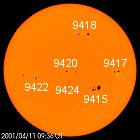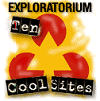|
  SPACE WEATHER SPACE WEATHER
Current
Conditions
Solar Wind
velocity: 756.6 km/s
density:11.5 protons/cm3
explanation
| more
data
Updated: Today at 1949 UT
X-ray Solar Flares
6-hr max: C5 1415 UT Apr11
24-hr: M2 1325 UT Apr11
explanation
| more
data
Updated: Today at 2015 UT
Daily
Sun: 11 Apr '01 
AR9415 has unleashed three X-class
solar flares since it appeared near the beginning of April. The active
region has a complex delta-class
magnetic field that likely harbors energy for even more
explosions.
Sunspot
Number: 170
More
about sunspots
Updated: 10 Apr 2001
Radio Meteor Rate
24 hr max: 28 per hr
Listen to the
Meteor Radar!
Updated: 11 Apr 2001
Interplanetary Mag.
Field
Btotal:
29.8
nT
Bz:
21.3
nT south
explanation | more
data
Updated: Today at 2017 UT
Coronal
Holes:

A substantial coronal hole is developing
in the Eastern half of the Sun's visible disk. Image credit: Yohkoh Soft
X-ray Telescope.
More about
coronal holes
 SPACE WEATHER SPACE WEATHER
NOAA
Forecasts
Solar Flares: Probabilities for a medium-sized (M-class) or
a major (X-class)
solar flare during the next 24/48 hours are tabulated below.
Updated at
2001 Apr 10 2200 UT
| FLARE |
24
hr |
48
hr |
| CLASS
M |
80 % |
80
% |
| CLASS
X |
25 % |
25
% |
Geomagnetic
Storms: Probabilities for significant disturbances in
Earth's magnetic field are given for three activity levels: active, minor storm, severe storm
Updated at
2001 Apr 10 2200 UT
Mid-latitudes
|
24
hr |
48
hr |
| ACTIVE |
15 % |
15
% |
| MINOR |
25 % |
25
% |
| SEVERE |
45 % |
45
% |
High
latitudes
|
24
hr |
48
hr |
| ACTIVE |
15 % |
25
% |
| MINOR |
30 % |
30
% |
| SEVERE |
50 % |
35
% |

Web server provided by
VPS
Hosting
|
|
What's Up in Space -- 11 Apr 2001
Subscribe
to Space Weather News!
GEOSTORM: A severe
(G4-category) geomagnetic storm is in progress.
It began at ~1400 UT (noon EDT) when a powerful solar wind
disturbance hit Earth's magnetosphere. The gust was probably the
first of two coronal mass ejections (CMEs) en route to Earth, or
perhaps a cannibalistic
combination of the
two. The interplanetary magnetic
field (IMF) around Earth has since developed
an intermittent but strong south-pointing component. Such IMFs are
favorable for the development of auroras.

Sky watchers who live
above ~45 degrees geomagnetic latitude should be alert for
Northern
Lights after
sunset on Wednesday. What's your geomagnetic latitude? Check out
these NOAA maps: North
America,
Eurasia, South
Africa & Australia, South
America
 INCOMING! On Tuesday, an X2-class solar
explosion above
sunspot 9415 hurled a
coronal mass ejection toward Earth. That CME (pictured right) joined another
one --launched by
a smaller solar flare the day before-- already en route to our
planet. Forecasters estimate a 25% chance of severe geomagnetic
storms at middle latitudes when the expanding clouds arrive. At
least one has already hit Earth's magnetosphere around 1330 UT on
Wednesday (see above). More information: INCOMING! On Tuesday, an X2-class solar
explosion above
sunspot 9415 hurled a
coronal mass ejection toward Earth. That CME (pictured right) joined another
one --launched by
a smaller solar flare the day before-- already en route to our
planet. Forecasters estimate a 25% chance of severe geomagnetic
storms at middle latitudes when the expanding clouds arrive. At
least one has already hit Earth's magnetosphere around 1330 UT on
Wednesday (see above). More information:
- LISTEN On mMonday a M8-class solar flare near sunspot 9415
produced a strong 50 MHz Type II radio burst recorded by radio
astronomer Tom Ashcraft. Listen to the two minute audio
file in the format of your choice: wav, RealPlayer, or MP3. Each of the files is
approximately 1.5 megabytes.
RADIATION STORM:
Tuesday's powerful
solar flare from sunspot group 9415 triggered an ongoing
S2-class solar radiation storm. The flux of
10 MeV solar protons around Earth is approximately 10,000 times
greater than normal. Such storms do not pose a hazard to air
travelers or astronauts.

WEB LINKS:
NOAA
FORECAST | GLOSSARY | SPACE WEATHER
TUTORIAL
| LESSON
PLANS |
BECOME A
SUBSCRIBER |


Potentially Hazardous Asteroids (PHAs) are space rocks
larger than approximately 100m that can come closer to Earth than 0.05 AU.
None of the known PHAs are on a collision course with our planet, although
astronomers are finding new ones all the time. [more]
On 11 Apr 2001 there
were 299 known Potentially
Hazardous
Asteroids
ASTEROIDS GALORE: March was a good month for asteroid hunters. Between March 21st
and 31st astronomers discovered seven Earth-approaching space rocks (click
to view 3D orbits): 2001
FM129, 2001
FE90, 2001
FB90, 2001
FD58, 2001
FC58, 2001
FA58 and 2001
FO32. There is no danger
of a collision with any of these asteroids.
Earth-asteroid encounters
(Mar 1 - Apr 30)

- TOTAL LUNAR
ECLIPSE: On Jan. 9, 2001, the full Moon glided
through Earth's copper-colored shadow. [gallery]
- CHRISTMAS
ECLIPSE: Sky watchers across North America
enjoyed a partial solar
eclipse on Christmas Day
2000 [gallery]
- LEONIDS 2000: Observers around the globe enjoyed three predicted episodes of
shooting stars. [gallery]

Feb. 21, 2001:
Nature's
Tiniest Space Junk -- Using an experimental radar at the
Marshall Space Flight Center, scientists are monitoring tiny but hazardous
meteoroids that swarm around our planet.
Feb. 15, 2001:
The Sun
Does a Flip -- NASA scientists who monitor the Sun
say our star's enormous magnetic field is reversing -- a sure sign that
solar maximum is here.
Jan. 25, 2001:
Earth's
Invisible Magnetic Tail -- NASA's IMAGE spacecraft, the first to
enjoy a global view of the magnetosphere, spotted a curious plasma tail
pointing from Earth toward the Sun.
Jan. 4, 2001:
Earth at
Perihelion -- On January 4, 2001, our planet made
its annual closest approach to the Sun.
Dec. 29, 2000:
Millennium
Meteors -- North Americans will have a front-row
seat for a brief but powerful meteor shower on January 3, 2001.
Dec. 28, 2000:
Galileo
Looks for Auroras on Ganymede --
NASA's durable Galileo
spacecraft flew above the solar system's largest moon this morning in
search of extraterrestrial "Northern Lights"
Dec. 22, 2000:
Watching the
Angry Sun -- Solar physicists are enjoying their
best-ever look at a Solar Maximum thanks to NOAA and NASA
satellites.
MORE SPACE
WEATHER HEADLINES |


 SPACE WEATHER
SPACE WEATHER







